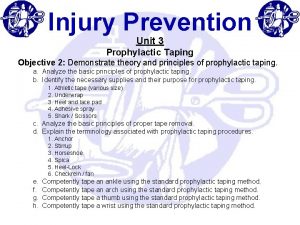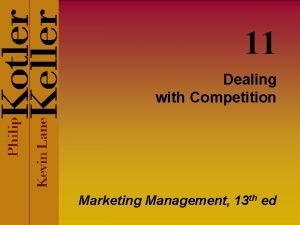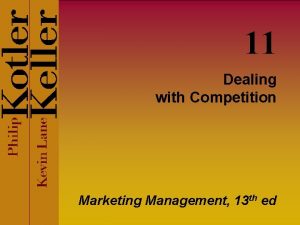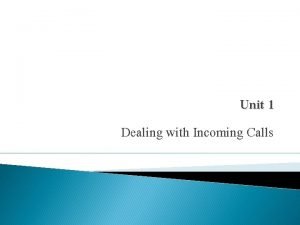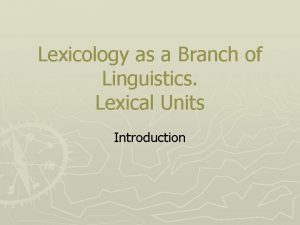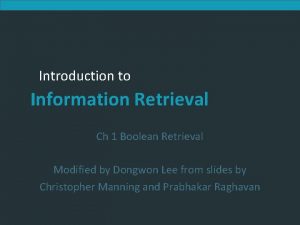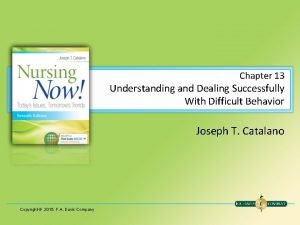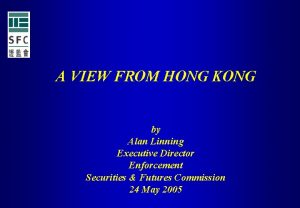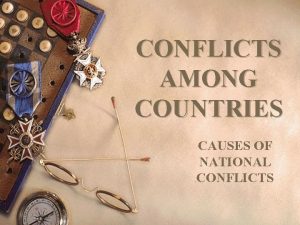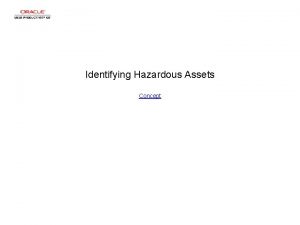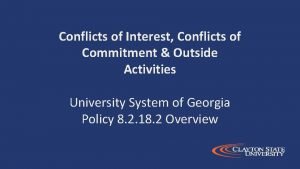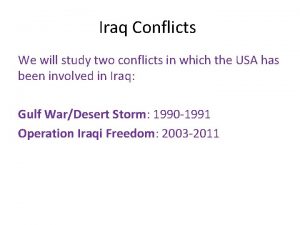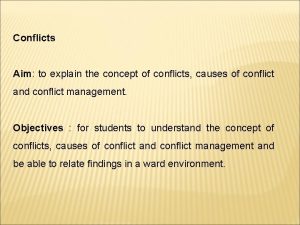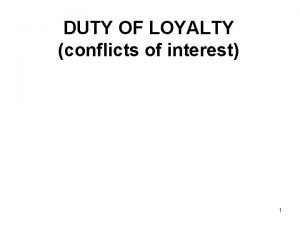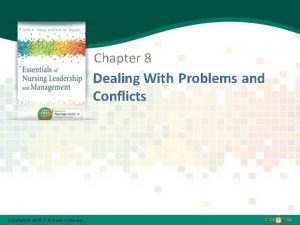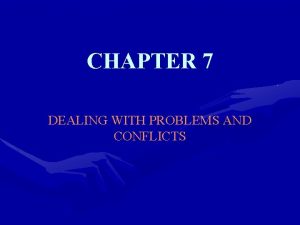IDENTIFYING AND DEALING WITH CONFLICTS PROPHYLACTIC APPROACH The




![CLIENT REMEDIES Civil an account of profits: Phipps v Boardman [1967] 2 AC 46 CLIENT REMEDIES Civil an account of profits: Phipps v Boardman [1967] 2 AC 46](https://slidetodoc.com/presentation_image/3091320c733db8d7c1b1e4b947450b83/image-5.jpg)





![SPECTOR V AGEDA [1973] CH 30 [48] A solicitor must put at his client’s SPECTOR V AGEDA [1973] CH 30 [48] A solicitor must put at his client’s](https://slidetodoc.com/presentation_image/3091320c733db8d7c1b1e4b947450b83/image-11.jpg)





![LEGAL SERVICES COMMISSIONER V DEVERY [2017] QCAT 155 In non-contentious matters, it is possible LEGAL SERVICES COMMISSIONER V DEVERY [2017] QCAT 155 In non-contentious matters, it is possible](https://slidetodoc.com/presentation_image/3091320c733db8d7c1b1e4b947450b83/image-17.jpg)
![R V PHAM [2017] QCA 43 Representing co-accused R V PHAM [2017] QCA 43 Representing co-accused](https://slidetodoc.com/presentation_image/3091320c733db8d7c1b1e4b947450b83/image-18.jpg)







![LAWYER CAN ACT FORMER CLIENT Prince Jefri Bolkiah v KPMG [1999] 2 AC 222, LAWYER CAN ACT FORMER CLIENT Prince Jefri Bolkiah v KPMG [1999] 2 AC 222,](https://slidetodoc.com/presentation_image/3091320c733db8d7c1b1e4b947450b83/image-26.jpg)







![THE LURE OF PERSONAL INTEREST Spector v Ageda [1973] Ch 30 at 47 The THE LURE OF PERSONAL INTEREST Spector v Ageda [1973] Ch 30 at 47 The](https://slidetodoc.com/presentation_image/3091320c733db8d7c1b1e4b947450b83/image-34.jpg)




![PROTECT THE ADMINISTRATION OF JUSTICE Kallinicos v Hunt (2005) 64 NSWLR 561 [76]: the PROTECT THE ADMINISTRATION OF JUSTICE Kallinicos v Hunt (2005) 64 NSWLR 561 [76]: the](https://slidetodoc.com/presentation_image/3091320c733db8d7c1b1e4b947450b83/image-39.jpg)
![R V SZABO [2000] QCA 194 The question might best be posed as whether, R V SZABO [2000] QCA 194 The question might best be posed as whether,](https://slidetodoc.com/presentation_image/3091320c733db8d7c1b1e4b947450b83/image-40.jpg)


- Slides: 42

IDENTIFYING AND DEALING WITH CONFLICTS

PROPHYLACTIC APPROACH The law requires lawyers to avoid being placed in a conflict of interest situation Cannot solve a potential or actual conflict by passing it to someone else in the organisation or another ‘associate’ (including immediate family) Where a conflict arises, informed consent of client(s) may cure this for the lawyer or law firm

TYPES OF CONFLICTS Same matter conflict (two sides of contentious matter) Loyalty conflicts where working for two clients in related matters but not necessarily confidential information relevant. Loyalty conflicts where working for two clients, for one and against one, in unrelated matters. Related matter conflict where previously acted for other side and/or some confidential information of the former client Law distinguishes between contentious and non-contentious matters

THREE GROUNDS TO INTERVENE IN LAWYER-CLIENT RELATIONSHIP RECOGNISED AT LAW AND ETHICALLY Lawyer acting would involve breach of lawyer’s duties of loyalty Lawyer acting poses a material risk of misuse of confidential information The administration of justice is endangered by the lawyer acting
![CLIENT REMEDIES Civil an account of profits Phipps v Boardman 1967 2 AC 46 CLIENT REMEDIES Civil an account of profits: Phipps v Boardman [1967] 2 AC 46](https://slidetodoc.com/presentation_image/3091320c733db8d7c1b1e4b947450b83/image-5.jpg)
CLIENT REMEDIES Civil an account of profits: Phipps v Boardman [1967] 2 AC 46 delivery-up and cancellation of documents; an injunction Disciplinary Complaint to LSC Breach of ASCR can constitute a disciplinary charge prosecuted in QCAT or Legal Practice Committee. Professional sanction possible may include an order for compensation.

ETHICAL DUTY OF LOYALTY ASCR, r 4. 1. 1: a solicitor must: act in the best interests of the client in any matter in which the solicitor represents the client.

COMMON LAW DUTY OF LOYALTY Contractual basis of relationship (whether in writing or not) Extent of duty may be moulded by contract However, note fiduciary relationship is the basis Law Society of New South Wales v Harvey [1976] 2 NSWLR 154 “An appreciation of that duty depends not upon some technical construction but upon applying the ordinary concepts of fair dealing between honourable men…”

DURATION OF THE LOYALTY (CIVIL) In Queensland, duty of loyalty does not survive the end of the lawyerclient relationship Compare to Victoria: Spincode v Look Software [2001] VSCA 248; Break Fast Investments v Rigby Cooke Lawyers [2015] VSC 305

ETHICAL DUTY OF LOYALTY (DISCIPLINE) Fordham v Legal Practitioners Complaints Committee (1997) 18 WAR 467 Fordham v The Legal Practitioners Complaints Committee [1998] HCATrans 387 Ethical duty not to adopt a position hostile to a former client in the same or a related matter

WHAT IS THE CONTENT OF THE DUTY? Depends on the contract Keeping client confidences (survives the contract) Tell the client all relevant information known to lawyer, even when received outside the lawyer-client relationship Prefer and advance interests of client (within the law and ethical rules)
![SPECTOR V AGEDA 1973 CH 30 48 A solicitor must put at his clients SPECTOR V AGEDA [1973] CH 30 [48] A solicitor must put at his client’s](https://slidetodoc.com/presentation_image/3091320c733db8d7c1b1e4b947450b83/image-11.jpg)
SPECTOR V AGEDA [1973] CH 30 [48] A solicitor must put at his client’s disposal not only his skill but also his knowledge, so far as is relevant; and if he is unwilling to reveal his knowledge to his client, he should not act for him. What he cannot do is act for the client and at the same time withhold from him any relevant knowledge that he has.

CONFLICTS ARISING Two or more current clients - we owe fiduciary and contractual duties to them at the same time. These duties may actually or potentially conflict. Must act in both cases. Former client’s confidence is ‘material’ to current client’s case. Fiduciary obligation to tell current client. Personal interests of the lawyer may conflict with the interests of the client.

ETHICAL RULES – CONCURRENT CLIENTS ASCR rule 11. 1 A solicitor and a law practice must avoid conflicts between the duties owed to two or more current clients, except where permitted by this Rule. ASCR rule 11. 2 If a solicitor or a law practice seeks to act for two or more clients in the same or related matters where the clients’ interests are adverse and there is a conflict or potential conflict of the duties to act in the best interests of each client, the solicitor or law practice must not act except r 11. 3 If in ‘best interests’ of clients AND each client knows the lawyer is acting and has given informed consent

ASCR – INFORMED CONSENT TO ACT FOR ONE WITH ACTUAL CONFLICT ASCR rule 11. 5 If a solicitor or a law practice acts for more than one client in a matter and, during the course of the conduct of that matter, an actual conflict arises between the duties owed to two or more of those clients, the solicitor or law practice may only continue to act for one of the clients (or a group of clients between whom there is no conflict) provided that the duty of confidentiality to other client(s) is not put at risk and the parties have given informed consent. Commentary advises that use of this rule will be in the ‘rarest of circumstances’. Generally consent cannot cure an actual conflict and lawyer must not represent either party

COMMON LAW – ACTUAL CONFLICTS There is no prohibition on accepting multiple clients, the problem is where there are conflicting duties owed to each by the law firm The prime example is acting on two sides of a case Prince Jefri Bolkiahv KPMG [1999] 2 AC 222, 234: ‘… a fiduciary cannot act at the same time both for and against the same client, and his firm is in no better position. A man cannot without the consent of both clients act for one client while his partner is acting for another in the opposite interest. ’

ACTUAL CONFLICTS ARISING If a lawyer takes on clients which result in conflicting duties ‘it is his own fault, and he cannot use his own discomfiture as a reason why his duty to either client should be taken to have been modified’: Hilton v Barker Booth & Eastwood (a firm) [2005] 1 WLR 567
![LEGAL SERVICES COMMISSIONER V DEVERY 2017 QCAT 155 In noncontentious matters it is possible LEGAL SERVICES COMMISSIONER V DEVERY [2017] QCAT 155 In non-contentious matters, it is possible](https://slidetodoc.com/presentation_image/3091320c733db8d7c1b1e4b947450b83/image-17.jpg)
LEGAL SERVICES COMMISSIONER V DEVERY [2017] QCAT 155 In non-contentious matters, it is possible to act for two parties – as co -purchasers of a property? Yes What happens when the lawyer becomes aware that one of the parties wants to sell their share still owing money to the other client? Can the lawyer assist the client; do they have to tell the other client? Thomas J found [28] to [30]: The facts of the case demonstrate the dangers associated with a legal practitioner acting on behalf of more than one party to any transaction, even commercial transactions where, at the time the lawyer acts, the interests of the two clients are not in conflict. As a result of acting in such transactions, the lawyer will obtain information about both sides which, in the event of a dispute, the lawyer may be under a duty to disclose to the other party. At least the lawyer should … define what will happen in the event that the position between the parties becomes contentious.
![R V PHAM 2017 QCA 43 Representing coaccused R V PHAM [2017] QCA 43 Representing co-accused](https://slidetodoc.com/presentation_image/3091320c733db8d7c1b1e4b947450b83/image-18.jpg)
R V PHAM [2017] QCA 43 Representing co-accused

INFORMED CONSENT In many cases of potential conflict, a lawyer may act where the client has given informed consent in writing being: ‘full candour and appropriately complete disclosure to the client’: Kirby P O’Reilly v Law Society of NSW (1988) 24 NSWLR 204 at 208; and advised to and possibly received independent legal advice

LIV ETHICS RULING R 4826 The parents of a four year old child born with a life-long medical disability brought a medical negligence claim against their health care provider for failing to diagnose the condition in utero. Because of the psychological harm to the parents allegedly caused by the negligence of the defendant, the marriage of the parents came to an end. It then became likely that there would be a dispute between the parents in relation to the quantum of their respective claims for economic loss if liability were to be established. The parents’ solicitors sought the guidance of the Ethics Committee in relation to their potential conflict of interest and the appropriate method of dealing with its resolution.

KEEP CONFIDENCES WITHIN FIRM ASCR rule 9. 1 A solicitor must not disclose any information which is confidential to a client and acquired by the solicitor during the client’s engagement to any person who is not: 9. 1. 1 a solicitor who is a partner, principal, director, or employee of the solicitor’s law practice; or 9. 1. 2 a barrister or an employee of, or person otherwise engaged by, the solicitor’s law practice or by an associated entity for the purposes of delivering or administering legal services in relation to the client,

CONFIDENTIAL INFO BROADLY DEFINED R 10. 1 ‘former client’ defined as anyone instructing the individual lawyer; their firm; their former firm while they worked there; current a partner or employee of the solicitor at their former firm or provided confidential information without a formal retainer Communicated in confidence, Still confidential Remembered or capable of being remembered Material or relevant to next matter. This could be ‘getting to know you factors’ such as the litigation strengths and weaknesses of the former client: Yunghanns v Elfic (SCV, unreported 13 July 1998).

LIV ETHICS RULINGS – R 4888 The husband is a solicitor who, for a 5 year period over 27 years ago, worked for the firm that now represents the wife in a family law proceeding. The husband has asserted that the firm are conflicted in acting for the wife because of confidential information relating to him and gained by the firm in the previous employment relationship. The nature of the information has been described by the husband as “getting to know you factors. ” The firm is of the view that it is not conflicted in continuing to act for the wife.

LIV ETHICS RULING R 4820 The wife objected to a Practitioner acting against her in family law and intervention order matters, alleging a conflict of interest. She alleged that the Practitioner had previously acted for both parties “in matters relating to real properties” and that she had twice consulted the Practitioner regarding those properties, and had then provided information to the Practitioner that could be deemed prejudicial to her. The Practitioner asserted it had never acted for the wife or received confidential information from her, but that three years previously it had acted for the husband in relation to a building dispute, and that on one or two occasions the wife had accompanied the husband to its office to collect cheques. Despite being asked for details of the matters in which she alleged that the Practitioner had acted for her and the details of the information she considered to be prejudicial to her no details were received from her.

INJUNCTIONS AGAINST LAWYERS TO PROTECT CONFIDENCES: SUMMARY An injunction can be granted before there is a breach The degree of risk of disclosure must be ‘real’ not merely ‘fanciful’ ‘Real possibility’ of disclosure Confidential information must be relevant or material For family law matters there is either a reverse onus or a broader test which only requires ‘ a theoretical possibility’ of information from a former client used
![LAWYER CAN ACT FORMER CLIENT Prince Jefri Bolkiah v KPMG 1999 2 AC 222 LAWYER CAN ACT FORMER CLIENT Prince Jefri Bolkiah v KPMG [1999] 2 AC 222,](https://slidetodoc.com/presentation_image/3091320c733db8d7c1b1e4b947450b83/image-26.jpg)
LAWYER CAN ACT FORMER CLIENT Prince Jefri Bolkiah v KPMG [1999] 2 AC 222, Lord Millet: No principle that a solicitor may not act against a former client; May be restrained to avoid a significant risk of disclosure or misuse of confidential information While strictly imposed on lawyer to keep confidences, the elements of the test for an injunction must be proved by the party seeking the injunction Changing sides against public interest? Prohibition result in ‘timid reluctance to risk some imaginary appearance of conflict which has no substance’ (Re a Firm of Solicitors (1992) 1 All ER 353)

WHAT IS A ‘REAL POSSIBILITY’? Matters are likely to be closely related where significant issues in one matter arise in the other, or factors significant to one matter are significant to the other: whether liability issues presented are similar; whether the nature of the evidence is similar; whether have interviewed a witness in both cases; knowledge of the former client’s trial strategies, negotiation strategies; knowledge of financial or organisational information or trade secrets; nature of former retainer and relationship. Family law ‘theoretical’ risk could involve knowledge of nonlawyers

ETHICAL DUTIES – FORMER CLIENTS ASCR r 10. 1 states: A solicitor and a law practice must avoid conflicts between the duties owed to current and former clients. ASCR r 10. 2 states: A solicitor and a law practice who or which is in possession of confidential information of a former client where that information might reasonably concluded to be material to the matter of another client and detrimental to the interests of the former client if disclosed, must not act for the current client in the matter unless: the former client has given informed written consent to the solicitor or law practice to so act; or an effective information barrier has been established.

ETHICAL DUTIES – MANAGING CONFIDENTIAL INFORMATION OF CURRENT CLIENTS ASCR rule 11. 4 In addition to the requirements of Rule 11. 3, where a solicitor or law practice is in possession of confidential information of a client (the first client) which might reasonably be concluded to be material to another client’s current matter and detrimental to the interests of the first client if disclosed, there is a conflict of duties and the solicitor’s law practice must not act for the other client, except as follows: 11. 4. 1 a solicitor may act where there is a conflict of duties arising from the possession of confidential information, where each client has given informed consent to the solicitor acting for another client; 11. 4. 2 a law practice (and the solicitors concerned) may act where there is a conflict of duties arising from the possession of confidential information where an effective information barrier has been established.

EXAMPLE Ms A has had advice about family law and dv. Her ex partner is Mr X, they have a child Jack. Ms B comes in for advice about family law and domestic violence, her ex partner is also Mr X. Ms B doesn’t know Ms A or Jack and Mr X hasn’t told her anything about them. Can you take on Ms B? What if Ms B does know about Ms A and Jack? Does it change if we are only giving one off advices rather than case file work?

DOES A CONFLICT HAVE AN EXPIRY DATE? This depends on the conflict. Yes if it arises as a duty of loyalty that expires when the contract finishes. There is no defence to say that confidential client information is not recalled: If there is no access to information can it be managed? The threshold may differ as between commercial and family law or criminal cases. In the latter case, the ‘theoretical’ change of a conflict needs to be protected.

THE PROBLEM OF IMPUTED KNOWLEDGE Lawyers with a firm are imputed with knowledge of the rest of the firm Rebuttable on evidence See comments in Babcock & Brown v Babcock & Brown [2015] VSC 453 [83] How do we deal with volunteers, students in clinics all of whom have or are working at other law firms? Shared spaces to see clients?

NO CONFLICTS - PERSONAL Rule 12. 1 A solicitor must not act for a client where there is a conflict between the duty to serve the best interests of a client and the interests of the solicitor. This includes others in the firm And includes a lawyer’s ‘associate’ such as a family member
![THE LURE OF PERSONAL INTEREST Spector v Ageda 1973 Ch 30 at 47 The THE LURE OF PERSONAL INTEREST Spector v Ageda [1973] Ch 30 at 47 The](https://slidetodoc.com/presentation_image/3091320c733db8d7c1b1e4b947450b83/image-34.jpg)
THE LURE OF PERSONAL INTEREST Spector v Ageda [1973] Ch 30 at 47 The solicitor must be remarkable indeed if he can feel assured of holding the scales evenly between himself and his client. Even if in fact he can and does, to demonstrate to conviction that he has done so will usually be beyond possibility in a case where anything to the client’s detriment has occurred. Not only must his duty be discharged, but it must manifestly and undoubtedly be seen to have been discharged.

BORROWING MONEY FROM THE CLIENT; LENDING TO A CLIENT ASCR, r 12. 3: a solicitor must not borrow any money … from a client See LSC v Jones [2015] QCAT 84 no a secret commissions or bribes: s 442 A Criminal Code (Qld).

PERSONAL PECUNIARY INTEREST Not only temptation to gain greater fees, could also include: Initiating or prolonging litigation (compare to ASCR 7. 2) Pressure to settle Over representation Concurrent business interests of lawyers Eg. Blackwatch Projects Pty Ltd v Cowling & Robert (a firm) [2016] QSC 291; BRJ v Council of NSW Bar Association [2016] NSWC 146

PERSONAL AND PROFESSIONAL RELATIONSHIPS No prohibition on forming a personal relationship with the client However, could easily become a breach of loyalty to client or abuse of administration of justice For instance, it may be hard to make rational decisions or lawyer may be more easily influenced to make a poor decision: LSC v La Spina [2012] QCAT (OCR 249 -10)

EXAMPLE Support staff or lawyer coming from large extended Indigenous families who may seek legal representation from the service. Are there any ‘lines in the sand’ that is recognised as conflict from a risk potential viewpoint? Lawyer related to the opposing party?
![PROTECT THE ADMINISTRATION OF JUSTICE Kallinicos v Hunt 2005 64 NSWLR 561 76 the PROTECT THE ADMINISTRATION OF JUSTICE Kallinicos v Hunt (2005) 64 NSWLR 561 [76]: the](https://slidetodoc.com/presentation_image/3091320c733db8d7c1b1e4b947450b83/image-39.jpg)
PROTECT THE ADMINISTRATION OF JUSTICE Kallinicos v Hunt (2005) 64 NSWLR 561 [76]: the court always has inherent jurisdiction to restrain solicitors from acting in a particular case, as an incident of its inherent jurisdiction over its officers and to control its process in aid of the administration of justice. The test to be applied in this inherent jurisdiction is whether a fair-minded, reasonably informed member of the public would conclude that the proper administration of justice requires that a legal practitioner should be prevented from acting, in the interests of the protection of the integrity of the judicial process and the due administration of justice, including the appearance of justice. The jurisdiction is to be regarded as exceptional and is to be exercised with caution. Due weight should be given to the public interest in a litigant not being deprived of the lawyer of his or her choice without due cause.
![R V SZABO 2000 QCA 194 The question might best be posed as whether R V SZABO [2000] QCA 194 The question might best be posed as whether,](https://slidetodoc.com/presentation_image/3091320c733db8d7c1b1e4b947450b83/image-40.jpg)
R V SZABO [2000] QCA 194 The question might best be posed as whether, with knowledge of all relevant circumstances, an ordinary fair-minded citizen in the position of the appellant would entertain a reasonable suspicion that justice had miscarried. Such a conclusion however does not necessarily follow from the mere fact that the Crown prosecutor and defence counsel have an association or even a sexual relationship. All relevant circumstances have to be considered, including the conduct displayed by defence counsel which might feed or rebut any suspicion of unfairness. (de Jersey CJ at [60])

INFORMATION BARRIERS Also often called ‘Chinese Walls’ Courts have tended to be sceptical of this administration process: [i]t appears to clad with respectable antiquity and impenetrability something that is relatively novel and potentially porous. It is a practice that apparently emanates from the United States of America, having been devised by large firms of lawyers in an attempt to justify representation of conflicting interests at the same time. Ipp J in Malleson Stephen Jacques v KPMG Peat Marwick (1990) 4 WAR 357

INFORMATION BARRIERS ARE ADMINISTRATIVE APPROACHES NOT LAW Conflict check before taking on client Physical separation of lawyers Client consents Undertakings by lawyers Computer security; hardcopy protection Education of lawyers Compliance officers Should be part of the firm's organisational structure, not created ad hoc Must be sufficient to demonstrate that there is no real risk of disclosure of the confidential information See Appendix B ASCR (with commentary)
 Identifying and non identifying adjective clauses
Identifying and non identifying adjective clauses How to identify clauses
How to identify clauses Identifying and non identifying adjective clauses
Identifying and non identifying adjective clauses Achilles tendon tape job
Achilles tendon tape job Prophylactic lovenox
Prophylactic lovenox Prophylactic definition
Prophylactic definition Ankle tape cutter
Ankle tape cutter Differences between virtual circuits and datagram networks
Differences between virtual circuits and datagram networks Deep learning approach and surface learning approach
Deep learning approach and surface learning approach Chapter 5 lesson 1 dealing with anxiety and depression
Chapter 5 lesson 1 dealing with anxiety and depression Chapter 5 lesson 1 dealing with anxiety and depression
Chapter 5 lesson 1 dealing with anxiety and depression Chapter 9 lesson 2 resolving conflicts
Chapter 9 lesson 2 resolving conflicts Chapter 9 resolving conflicts and preventing violence
Chapter 9 resolving conflicts and preventing violence The old man and the sea criticism
The old man and the sea criticism External conflict in act 2 of the crucible
External conflict in act 2 of the crucible Theoretical models of counseling
Theoretical models of counseling Waterfall and sprinkler strategy
Waterfall and sprinkler strategy Multiple approach avoidance conflict
Multiple approach avoidance conflict Cognitive approach vs behavioral approach
Cognitive approach vs behavioral approach What is research approach
What is research approach Traditional approach in system analysis and design
Traditional approach in system analysis and design Branch of linguistics dealing with meaning
Branch of linguistics dealing with meaning Examples of abiotic factors
Examples of abiotic factors Section 2 dealing with other nations
Section 2 dealing with other nations Call center stress
Call center stress Market follower
Market follower Is a genre of speculative fiction
Is a genre of speculative fiction Dealing with competition marketing management
Dealing with competition marketing management Unit 1 dealing with incoming calls
Unit 1 dealing with incoming calls Dealing with anger in the bible
Dealing with anger in the bible Dealing successfully with difficult changes in your life.
Dealing successfully with difficult changes in your life. Areas of lexicology
Areas of lexicology A play with a sad or unhappy ending
A play with a sad or unhappy ending Dealing with unstructured data
Dealing with unstructured data Reuters electronic trading
Reuters electronic trading Dealing with unstructured data
Dealing with unstructured data The branch of zoology dealing with insects
The branch of zoology dealing with insects The branch of zoology dealing with insects
The branch of zoology dealing with insects Dealing with challenging patients
Dealing with challenging patients Dealing successfully with difficult changes in your life
Dealing successfully with difficult changes in your life Dealing with unstructured data
Dealing with unstructured data Alan linning
Alan linning Resolve complaint
Resolve complaint



